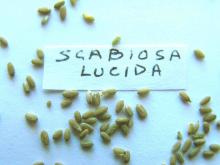I think everyone is familiar with the shuttlecock look of Scabiosa seeds. Indeed, it's that structure that makes this genus so attractive in the garden after the blossoms fade and in dried flower arrangements. But are those shuttlecocks the actual seeds or just an ornamental "sleeve" for disbursing the true seed?
I can sometimes get quite vigorous when cleaning my seed. One day while cleaning Scabiosa shuttlecocks, I noticed something very small on my paper plate that looked like a typical seed. As first I thought it was just a stray seed from a nearby unrelated species that was inadvertently gathered with the Scabiosa. But, as I rubbed the shuttlecocks, a few more of those seeds appeared.
To confirm they were, indeed, viable Scabiosa seeds, I germinated a few. I was surprised at how fast they germinated with nearly 100% success rate. In the past, I had tried to introduce a dwarf, compact Scabiosa into my garden from shuttlecocks I collected from town plantings. I got no germination.
I am now noticing that in any given lot of shuttlecocks, there are less than 50% "real" seeds expelled. So I think I was unsuccessful with my original attempt at germination because those shuttlecocks were empty of seed.
Here's a photo of the seeds that I've teased out of those shuttlecocks. Has anyone else noticed this?
Comments
Re: Scabiosa seeds
Mark,
I'm familiar with the "exoskeleton" or netting around Castilleja seeds. Actually, I initiated that topic some time ago. But this is different. The "shuttlecock" structure doesn't seem to bind to the seed like it does with Castilleja. You might look at it like a "basket". From the small number of seeds I get from a large number of shuttlecocks, I'm assuming there is only one seed per shuttlecock and many of the seeds either drop out or possibly are eaten while the seedheads are still intact on the stems. If my suppositions are true, that would mean people who receive Scabiosa "seed" (shuttlecocks) may, instead, get empty "baskets".


jane, I have not notice that first hand, but it reminds me of Castilleja seed that has a sort of exoskeleton structure around the tree seed. It was discussed here, although I notice some of the Paririe Moon nursery links that show close-ups of seed, have become dead links and need to be repathed.
http://nargs.org/smf/index.php?topic=515.0